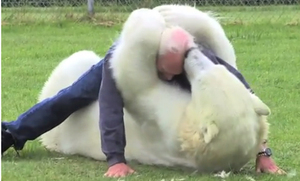 The polar bear is a native of the frozen arctic area. Some people believe that the name arctic, which is derived from the Greek word for bear, refers to the presence of polar bear in the area, and the word Antarctic refers to its Greek meaning of a place without bear. However, the reference to bear can also be a reference to the constellations ‘Great Bear’ and ‘Little Bear’.
The polar bear is a native of the frozen arctic area. Some people believe that the name arctic, which is derived from the Greek word for bear, refers to the presence of polar bear in the area, and the word Antarctic refers to its Greek meaning of a place without bear. However, the reference to bear can also be a reference to the constellations ‘Great Bear’ and ‘Little Bear’.
Arctic seals, or more specifically the high calorie seal fat, are the main food source of polar bears. The available statistics show that there could be a maximum 25000 polar bears in the world. A polar bear’s body is adapted to survive in temperatures as low as -45oC, and global warming can sound the death knell of these beautiful creatures.
Polar bears are in the topmost position in the arctic food chain because they have no predators. Man is the only living thing that may attack or kill a polar bear. When food is scarce, sometimes polar bears may fight and kill each other. But despite this enemy-less existence, their recorded lifespan in their natural habitat does not exceed an average of 18 years. In captivity they are seen to fare much better, living even into their late 30s. A polar bear named Debby lived up to the age of 42 in a Canadian zoo.
It may not be easy to give a polar bear the type of food and temperature and space it requires, but so far as a person has the wherewithal and the dedication to do it, he can get a license to raise a polar bear as a pet.
Agee is an 800 pound polar bear that has been raised by Mark Dumas and his wife from the time she was six weeks old. She is now 16 years old and her owner is 60 years old and together they do many things that pet dogs and their owners do. Agee is also a movie star, having acted in the film ‘Alaska’ when she was only a couple of weeks old. In the Canadian city of Abbotsford in British Columbia, where Agee lives, the temperature is not arctic but the bear seems to be comfortable there.
Agee is not fed on seal fat but on protein-rich things like chicken and salmon, plenty of carbohydrates, some dog food items, and necessary vitamin supplement. She has developed a taste for many human delicacies. She is trained to work in films and every time she obeys a command correctly she is rewarded with cookies, chocolates, and steak that she seems to enjoy.
Even in their natural habitat, during summers polar bears have to survive on a scavenger diet when seal fat is not available. Because of this they have an adaptable digestive system.
We have to believe that a polar bear raised in captivity does not lose all of its wildlife instincts because there has been a report that a man-raised polar bear in Japan lunged at a girl dressed as a seal.